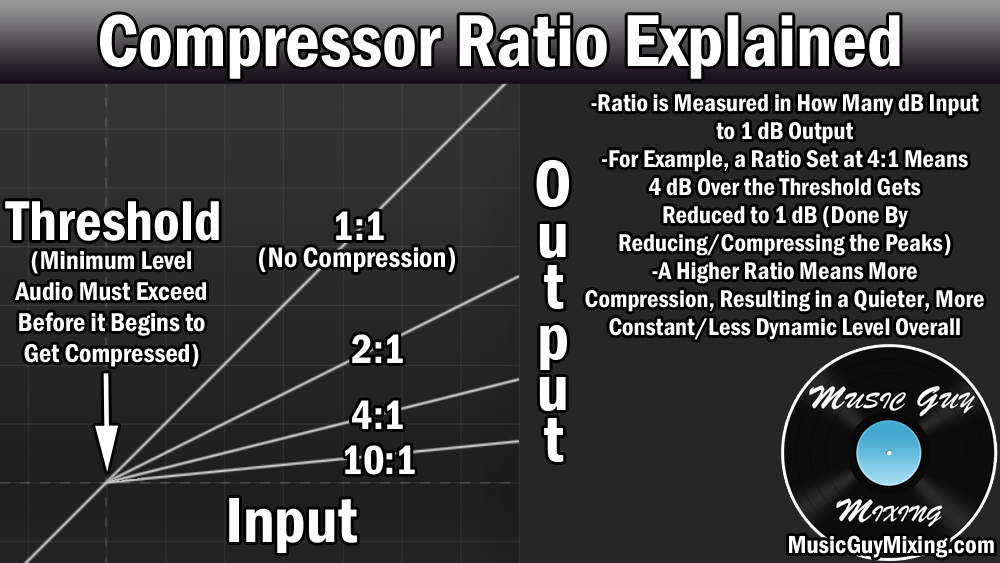Limiters are forms of compression which set a ceiling on your audio which limits the level at which the volume can reach (hence the name). While limiting is typically thought of as being a tool which is primarily or exclusively used in the mastering process for getting more volume out of a master, it has a place in your mix, as well. Let’s identify what is a limiter and how to use a limiter in mixing.
What is a Limiter

As I alluded to in opening, a limiter is a form of compression. The difference between a conventional compressor and a limiter is that on a limiter the ratio is essentially infinite.
Whereas a typical compressor ratio would be set somewhere between 2:1 and 8:1 in order to turn down anything which exceeds the threshold by a varying amount of decibels, with a limiter’s infinite ratio, anything which exceeds that threshold gets output at the exact same volume. The threshold essentially becomes a flat ceiling which no peak can pass.
You can see this in action in my tutorial on the compressor ratio explained:

The higher that ratio goes, the closer the output flattens out. Feeding different levels into a compressor at lower ratios will output different volumes.
If we turn that ratio all the way up, that’s when it becomes a limiter. At that point, it doesn’t matter if our audio would otherwise exceed our threshold by 1dB or 100dB – it’s all getting compressed and output at the exact same volume, hitting that ceiling.
Why would we want to do this? Let’s move on to cover how to use a limiter in your mix to explain this.
How to Use a Limiter in Your Mix
Limiters have a number of applications, but they mostly boil down to two major purposes.
The first and the one which we typically associate with limiting is in the audio mastering stage.
Mastering engineers use limiters or maximizers at the end of the signal chain to turn up the volume as much as possible while avoiding audio clipping.
This gets your completed song to a competitive and comparable volume with other commercial masters so that your song doesn’t sound quieter/weaker than the songs around it in a mix on a streaming service (for example).
There’s no point in using a limiter in the mixing stage, at least driving it to the point of gain reduction. In the mixing stage, we want to practice gain staging to get the most out of our audio and maintain some headroom for the mastering stage. If you want your mix to be louder while you’re mixing, simply turn up your speakers or headphones.
The second major purpose which limiters have, and the one which is applicable to the mixing stage, is as a form of extreme compression.
Sometimes you’re willing to sacrifice dynamic range to get a constant volume out of your audio.
The bass is a prime example. While I talked about how to compress bass guitar in the past, I recommended an 8:1 ratio if not more.
While that’s a more natural way to get more cohesion out of the audio, sometimes your bass guitar or bass in general can benefit from the infinite ratio associated with limiters.
Here I have an especially dynamic bass part, alternating between octave notes with a complex rhythm. With the limiter I’m turning the gain which is essentially the threshold on the limiter up so that I’m crushing that input:

I kept about 20ms of attack to let those transient peaks surge through before that limiter clamps down.
In this track’s case, I actually have the limiter set up after a conventional compressor, so I’ve got some serial compression going on here. As such, I’ve ultimately got a lot more than the 9dB on average of gain reduction happening on this limiter, relative to the raw recorded bass.
Note that I’m still turning the output of the limiter down considerably to match the input level to maintain our gain staging.
Raising the volume obviously isn’t the goal here, we just want a relatively dynamic-free sausage clip of audio to keep that bass present every second of the performance.
You can see there’s still a couple dB difference between the gain reduction on those peaks. If I wanted the level to be even more constant, I’d add one more limiter after this one in the chain.
This sacrifices those dynamics, but it keeps that bass front and center – a technique you’ll hear a lot on pop records.
I just use bass as an example – You can use a limiter or limiters on a number of tracks you want up front in the mix.
Vocals are an obvious choice, particularly in pop where transparency isn’t the goal.
A lot of mixing engineers love to use limiters on their kick or snare to ensure every single hit of these two essential ingredients are constant throughout the mix.
Some old school mixing engineers may balk at this with the argument that you’re killing the life of the track with the dynamics, but remember – there are no rules.
The only rule in mixing (aside from my evergreen music mixing tips) is that if it sounds good, do it.

Pingback: How to Use Compression on Bass - The Best Settings - Music Guy Mixing
Pingback: The Best Mixer Settings for Vocals - Music Guy Mixing